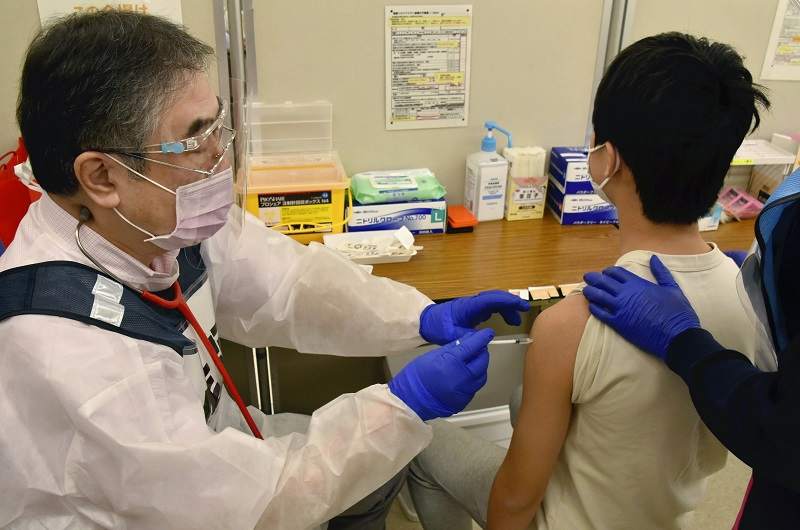
A child receives a vaccine shot in Morioka in March.
6:00 JST, August 11, 2022
The COVID-19 vaccination rate for children aged 5-11 years was six times higher in Akita Prefecture than in Osaka Prefecture, according to a Yomiuri Shimbun tally.
The data revealed a gap in child vaccination rates between eastern and western Japan, with the highest rate logged in Akita Prefecture, at 45.9%, and the lowest in Osaka Prefecture, at 7.4%.
The full-scale vaccination campaign for children in the age group began in March, with recipients getting two shots, three weeks apart.
Currently, parents are not urged to get children vaccinated under the Immunization Law, but the government plans to do so from September at the earliest, based on the assumption that the effectiveness of the shots has been confirmed.
The government has published data on vaccination rates by age group, but not by prefecture.
The Yomiuri Shimbun contacted prefectural governments to find out the vaccination rates of children in the age group as of Aug. 1 and received responses from all prefectures apart from Aomori and Okinawa.
Akita had the highest percentage of children aged 5 to 11 who had received their first vaccine shot, followed by Yamagata Prefecture at 44.4% and Fukushima Prefecture at 39.5%.
The rate was 19.5% in Tokyo, which has the highest number of eligible recipients in the age group — about 760,000 children. The national average was 18.4%.
Among prefectures where the vaccination rates were low, Osaka Prefecture was followed by Wakayama at 10.3%, Hyogo at 10.7%, Kyoto at 11.0% and Nara at 11.5% — all of which are in the Kansai region.
In the same five prefectures, the percentage of people in their 20s to 30s who had received three doses of a vaccine was 30%-49%. Akita Prefecture logged the highest rate for the same demographic at more than 60%.
“There might be a strong awareness among parents who have been vaccinated to also get their children inoculated,” an Akita prefectural official said.
“If parents don’t get vaccinated, it is only natural to assume that their children won’t either,” said Prof. Hiroyuki Kunishima of St. Marianna University School of Medicine. “If children get infected, educational opportunities might be lost and the infection may spread within their households. Local governments should make an effort to help people understand that vaccines can be an option to avoid such risks.”
"Society" POPULAR ARTICLE
-

M4.9 Earthquake Hits Tokyo, Neighboring Prefectures
-

M7.5 Earthquake Hits Northern Japan; Tsunami Waves Observed in Hokkaido, Aomori and Iwate Prefectures
-

Tsukiji Market Urges Tourists to Avoid Visiting in Year-End
-

Israeli Tourists Refused Accommodation at Hotel in Japan’s Nagano Pref., Prompting Protest by Israeli Embassy and Probe by Prefecture
-

M5.7 Earthquake Hits Japan’s Kumamoto Pref., Measuring Upper 5 Intensity, No Tsunami Expected
JN ACCESS RANKING
-

Keidanren Chairman Yoshinobu Tsutsui Visits Kashiwazaki-Kariwa Nuclear Power Plant; Inspects New Emergency Safety System
-

Imports of Rare Earths from China Facing Delays, May Be Caused by Deterioration of Japan-China Relations
-

University of Tokyo Professor Discusses Japanese Economic Security in Interview Ahead of Forum
-

Japan Pulls out of Vietnam Nuclear Project, Complicating Hanoi’s Power Plans
-

Govt Aims to Expand NISA Program Lineup, Abolish Age Restriction























